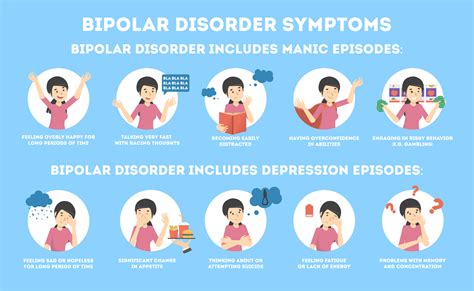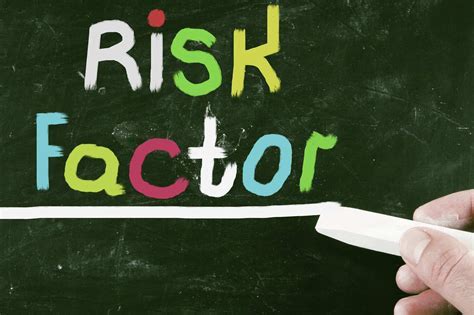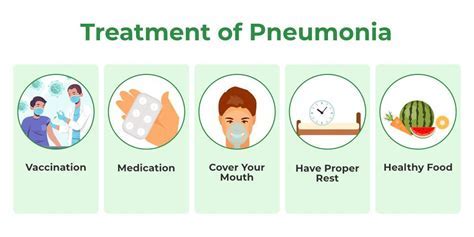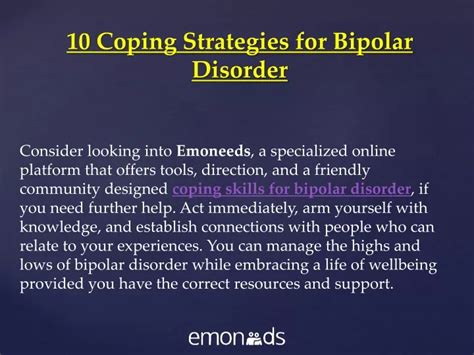Intro
Discover Bipolar 1 Disorder symptoms, including manic episodes, mood swings, and depressive states, to understand this complex mental health condition and its effects on daily life, diagnosis, and treatment options.
Bipolar 1 disorder is a mental health condition that affects millions of people worldwide, causing significant emotional, social, and economic burdens. The disorder is characterized by extreme mood swings, ranging from manic highs to depressive lows, which can impact an individual's daily life, relationships, and overall well-being. Understanding the symptoms of bipolar 1 disorder is crucial for early diagnosis, effective treatment, and improved management of the condition. In this article, we will delve into the world of bipolar 1 disorder, exploring its symptoms, causes, diagnosis, and treatment options.
The importance of recognizing bipolar 1 disorder symptoms cannot be overstated. If left untreated, the condition can lead to severe consequences, including suicidal thoughts, substance abuse, and strained relationships. Furthermore, bipolar 1 disorder can co-occur with other mental health conditions, such as anxiety disorders, attention deficit hyperactivity disorder (ADHD), and substance use disorders, making diagnosis and treatment even more complex. By educating ourselves about the symptoms of bipolar 1 disorder, we can better support individuals affected by the condition and promote a culture of understanding and acceptance.
Bipolar 1 disorder is a complex condition, and its symptoms can vary from person to person. However, there are some common symptoms that are characteristic of the disorder. These symptoms can be broadly categorized into manic, depressive, and mixed episodes. Manic episodes are marked by elevated mood, increased energy, and reduced need for sleep. Depressive episodes, on the other hand, are characterized by low mood, loss of interest in activities, and changes in appetite and sleep patterns. Mixed episodes combine symptoms of both manic and depressive episodes, making diagnosis and treatment more challenging.
Bipolar 1 Disorder Symptoms

The symptoms of bipolar 1 disorder can be divided into several categories, including manic, depressive, and mixed episodes. Manic episodes are characterized by:
- Elevated mood, which can range from feeling happy and optimistic to feeling irritable and agitated
- Increased energy and activity levels, which can lead to reckless behavior and poor decision-making
- Reduced need for sleep, which can result in fatigue and decreased productivity
- Increased self-esteem and grandiosity, which can lead to inflated self-importance and poor relationships
- Distractibility and difficulty concentrating, which can impact work and daily activities
- Increased talkativeness and pressured speech, which can be overwhelming for others
Depressive episodes, on the other hand, are marked by:
- Low mood, which can range from feeling sad and hopeless to feeling empty and apathetic
- Loss of interest in activities, which can lead to social isolation and decreased productivity
- Changes in appetite and sleep patterns, which can result in weight changes and fatigue
- Fatigue and decreased energy levels, which can impact daily activities and relationships
- Difficulty concentrating and making decisions, which can impact work and daily life
- Recurrent thoughts of death and suicidal ideation, which require immediate attention and support
Manic Episodes
Manic episodes are a hallmark of bipolar 1 disorder, and they can be incredibly challenging to manage. During a manic episode, an individual may feel invincible, energetic, and creative, but they may also engage in reckless behavior, such as excessive spending, substance abuse, or risky sexual behavior. Manic episodes can be triggered by various factors, including stress, sleep deprivation, and certain medications.Causes and Risk Factors

The exact causes of bipolar 1 disorder are still not fully understood, but research suggests that it is a complex interplay of genetic, environmental, and neurochemical factors. Individuals with a family history of bipolar disorder are more likely to develop the condition, and certain genetic mutations can increase the risk of developing the disorder. Environmental factors, such as trauma, stress, and substance abuse, can also trigger the onset of bipolar 1 disorder.
Genetic Factors
Genetic factors play a significant role in the development of bipolar 1 disorder. Individuals with a family history of bipolar disorder are more likely to develop the condition, and certain genetic mutations can increase the risk of developing the disorder. Research has identified several genes that are associated with an increased risk of developing bipolar 1 disorder, including the DRD4 gene and the DAT1 gene.Diagnosis and Treatment

Diagnosing bipolar 1 disorder can be challenging, as the symptoms can be similar to those of other mental health conditions. A comprehensive diagnostic evaluation, including a physical exam, laboratory tests, and a psychological assessment, is necessary to confirm the diagnosis. Treatment for bipolar 1 disorder typically involves a combination of medications, psychotherapy, and lifestyle changes.
Treatment Options
Treatment options for bipolar 1 disorder include: * Mood stabilizers, such as lithium and valproate, which can help regulate mood and prevent manic and depressive episodes * Antipsychotics, such as olanzapine and risperidone, which can help manage symptoms of mania and psychosis * Antidepressants, such as fluoxetine and sertraline, which can help manage symptoms of depression * Psychotherapy, such as cognitive-behavioral therapy and family-focused therapy, which can help individuals develop coping skills and improve relationshipsCoping with Bipolar 1 Disorder

Coping with bipolar 1 disorder requires a comprehensive approach that includes self-care, social support, and professional treatment. Individuals with bipolar 1 disorder can benefit from:
- Keeping a mood journal to track symptoms and identify patterns
- Developing a daily routine to maintain structure and stability
- Engaging in regular exercise and physical activity to improve mood and reduce stress
- Practicing stress-reducing techniques, such as meditation and yoga, to manage stress and anxiety
- Building a support network of friends, family, and mental health professionals to provide emotional support and guidance
Self-Care Strategies
Self-care strategies are essential for managing bipolar 1 disorder. Individuals can benefit from: * Getting enough sleep and maintaining a consistent sleep schedule * Eating a healthy and balanced diet to improve mood and reduce symptoms * Avoiding substance abuse and engaging in healthy coping mechanisms * Practicing relaxation techniques, such as deep breathing and progressive muscle relaxation, to reduce stress and anxiety * Engaging in activities that bring joy and fulfillment, such as hobbies and creative pursuitsConclusion and Next Steps

In conclusion, bipolar 1 disorder is a complex and challenging condition that requires comprehensive treatment and support. By understanding the symptoms, causes, and treatment options, individuals can better manage their condition and improve their overall quality of life. If you or someone you know is struggling with bipolar 1 disorder, it is essential to seek professional help and support.
We invite you to share your thoughts and experiences with bipolar 1 disorder in the comments section below. Your input can help others better understand the condition and provide valuable insights for managing symptoms and improving treatment outcomes. Additionally, we encourage you to share this article with others who may be struggling with bipolar 1 disorder, as education and awareness are essential for promoting understanding and acceptance.
What are the symptoms of bipolar 1 disorder?
+The symptoms of bipolar 1 disorder include manic episodes, depressive episodes, and mixed episodes. Manic episodes are characterized by elevated mood, increased energy, and reduced need for sleep, while depressive episodes are marked by low mood, loss of interest in activities, and changes in appetite and sleep patterns.
How is bipolar 1 disorder diagnosed?
+Bipolar 1 disorder is diagnosed through a comprehensive diagnostic evaluation, including a physical exam, laboratory tests, and a psychological assessment. A mental health professional will assess the individual's symptoms, medical history, and family history to confirm the diagnosis.
What are the treatment options for bipolar 1 disorder?
+Treatment options for bipolar 1 disorder include medications, such as mood stabilizers and antipsychotics, psychotherapy, and lifestyle changes. A mental health professional will work with the individual to develop a personalized treatment plan that addresses their specific needs and symptoms.
